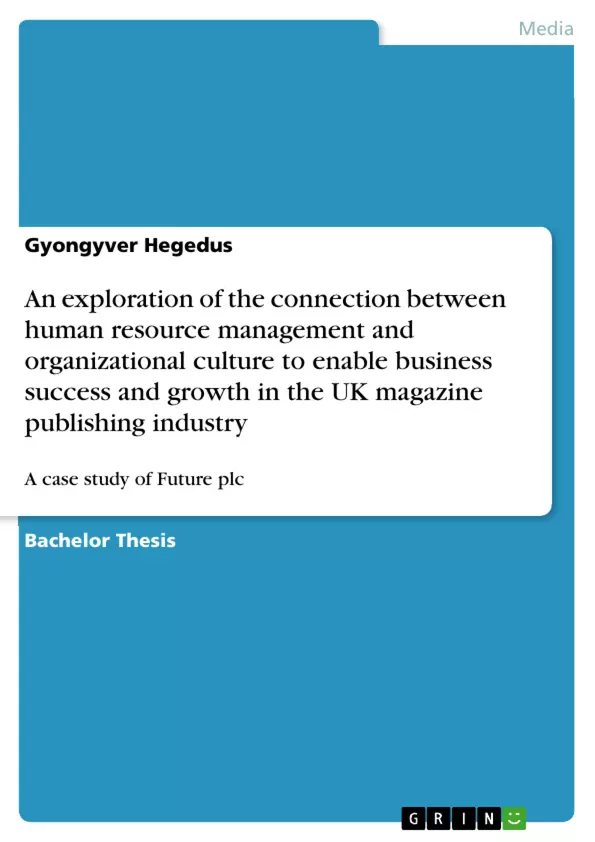This research bridges the relationship between strategic human resource management and organisational culture to enable business success and growth in the magazine publishing industry based on a case study of Future plc, one of the leading companies in the specialist magazine sector in the UK. The specific aims that were accomplished over the course of this investigation include an exploration of the extant literature regarding organisational culture and strategic human resource management; a presentation of theory and empirical evidence regarding the impact of human resource management and organisational culture on organisational development; and the completion of a case study of Future Plc.
A research strategy was to use a mixed-method survey that was administered to a selected group of Future Plc managers, offering evidence of policies, strategies, and expectations that continue to govern employee hiring, motivation, training, and long term development, and to follow a traditional case study format. The primary research was based on a variety of books and academic journals to search for key terms that were relevant to the main topic. The survey was divided into three segments, the first two were made up of quantitative queries and the third was based on open-ended qualitative questions.
The findings suggested that there is an innate connection between communications, employee motivation and business success.. Future plc motivates its employees by providing access to comprehensive tailor-made internal training, formal appraisal, recognition and the possibility of promotion instead of offering more money. The company currently epitomises the focus on strengths of organisational participants, as its varied branches are thinned and refocused towards more specific long term objectives. Managers queried, agreed that in order to establish a successful protocol for long term growth, cultural commitment must be maintained and that business success and development needs long-term objectives, although at present it seems that there is a lack of agreement between the expectation of partnership and its practice within the company. The survey findings suggested that managers believe, it is not important to hold regular meetings to inform staff about the changes that takes place within the company and that the departments do not communicate effectively resulting in bad performance. [...]
Inhaltsverzeichnis (Table of Contents)
- Abstract
- Table of content
- Table of figures
- Introduction
- Aims and Objectives
- Key terms
- Report structure
- Industry analysis
- The specialist magazine market
- Advertising overview
- Online publishing overview
- Marketing Overview
- Future Prospects
- Future plc. Profile
- Changes at Future plc.
- Literature review
- An overview of Human Resource Management
- Working in the magazine publishing industry
- Qualifications
- Roles
- Organisational structure
- Motivation and Job Satisfaction
- Learning and Training
- Organisational culture
- Organizational development and change
- Methodology
- Research Design
- Secondary research
- Primary research
- Participants
- Limitations to the study
- Data presentation
- Management
- Motivation
- Training
- Business growth
- Organisational Change
- Qualitative data analysis
- Discussion, Conclusions and Recommendations
- Discussion
- Motivation, Job Satisfaction and Reward
- Training
- Organisational culture
- Long term objectives and business development
- Communication
- Conclusions
- Recommendations
- Discussion
- Bibliography
- Appendix
Zielsetzung und Themenschwerpunkte (Objectives and Key Themes)
This research explores the relationship between strategic human resource management and organizational culture to facilitate business success and growth within the UK magazine publishing industry, utilizing a case study of Future plc. The study aims to analyze existing literature on organizational culture and strategic human resource management, to present theory and empirical evidence regarding the impact of human resource management and organizational culture on organizational development, and to conduct a case study of Future plc. Key themes explored in this research include:- The role of strategic human resource management in organizational development
- The impact of organizational culture on employee motivation and job satisfaction
- The connection between organizational culture and business growth
- The challenges and opportunities of managing change in a dynamic industry
- The significance of communication and collaboration in organizational success
Zusammenfassung der Kapitel (Chapter Summaries)
- Chapter 1: Introduction - This chapter lays the foundation for the study by outlining its aims and objectives, key terms, and report structure.
- Chapter 2: Industry analysis - This chapter provides an overview of the specialist magazine market in the UK, including advertising, online publishing, and marketing trends. It also examines the profile and changes within Future plc, a leading company in the sector.
- Chapter 3: Literature review - This chapter explores existing literature on human resource management, working in the magazine publishing industry, employee motivation and job satisfaction, learning and training, organizational culture, and organizational development and change.
- Chapter 4: Methodology - This chapter describes the research design, secondary research, primary research methods, participants, and limitations of the study.
- Chapter 5: Data presentation - This chapter presents the findings of the research, including data on management, motivation, training, business growth, organizational change, and qualitative data analysis.
Schlüsselwörter (Keywords)
This research focuses on the intersection of strategic human resource management, organizational culture, and business success within the UK magazine publishing industry. Key terms include: strategic human resource management, organizational culture, employee motivation, job satisfaction, training, organizational development, change management, communication, and Future plc. This study examines how these elements contribute to organizational growth and performance in a rapidly evolving industry.- Arbeit zitieren
- Gyongyver Hegedus (Autor:in), 2010, An exploration of the connection between human resource management and organizational culture to enable business success and growth in the UK magazine publishing industry, München, GRIN Verlag, https://www.grin.com/document/151171



